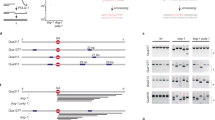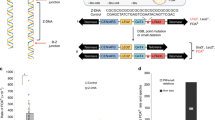Abstract
DNA helicases are involved in many aspects of DNA metabolism, including transcription, replication, recombination and repair. In the yeast Saccharomyces cerevisiae, the absence of the Sgs1 helicase results in genomic instability and accelerated ageing1,2,3,4. In human cells, mutations in orthologues of SGS1 lead to Bloom (BS), Werner (WS) or Rothmund-Thomson (RTS) syndromes, which are rare, autosomal recessive diseases characterized by genetic instability associated with cancer predisposition5,6,7. Although data concerning these human diseases are accumulating, there is still no clear idea of the function of the proteins involved. Here we show that sgs1Δ mutants are deficient in DNA repair and are defective for induced recombination events that involve homologous chromosomes. The role of homologous recombination is further evidenced in haploid cells in which both Sgs1p and Srs2p are absent. Yeast SRS2 encodes another DNA helicase involved in the maintenance of genome integrity8,9,10. Our data suggest that some defects observed in BS, WS or RTS are the consequence of unrestrained recombination.
This is a preview of subscription content, access via your institution
Access options
Subscribe to this journal
Receive 12 print issues and online access
$209.00 per year
only $17.42 per issue
Buy this article
- Purchase on Springer Link
- Instant access to full article PDF
Prices may be subject to local taxes which are calculated during checkout



Similar content being viewed by others
References
Gangloff, S., McDonald, J.P., Bendixen, C., Arthur, L. & Rothstein, R. The yeast type I topoisomerase Top3 interacts with Sgs1, a DNA helicase homolog: a potential eukaryotic reverse gyrase. Mol. Cell. Biol. 14, 8391– 8398 (1994).
Rothstein, R. & Gangloff, S. Hyper-recombination and Bloom's syndrome: microbes again provide clues about cancer. Genome Res. 5, 421–426 ( 1995).
Watt, P.M., Hickson, I.D., Borts, R.H. & Louis, E.J. SGS1, a homologue of the Bloom's and Werner's syndrome genes, is required for maintenance of genome stability in Saccharomyces cerevisiae. Genetics 144, 935–945 ( 1996).
Sinclair, D.A., Mills, K. & Guarente, L. Accelerated aging and nucleolar fragmentation in yeast sgs1 mutants. Science 277, 1313– 1316 (1997).
Yu, C.E. et al. Positional cloning of the Werner's syndrome gene. Science 272, 258–262 ( 1996).
Kitao, S. et al. Mutations in RECQL4 cause a subset of cases of Rothmund-Thomson syndrome. Nature Genet. 22, 82– 84 (1999).
Ellis, N.A. et al. The Bloom's syndrome gene product is homologous to RecQ helicases . Cell 83, 655–666 (1995).
Aboussekhra, A. et al. RADH, a gene of Saccharomyces cerevisiae encoding a putative DNA helicase involved in DNA repair. Characteristics of radH mutants and sequence of the gene. Nucleic Acids Res. 17, 7211–7219 (1989).
Rong, L., Palladino, F., Aguilera, A. & Klein, H.L. The hyper-gene conversion hpr5-1 mutation of Saccharomyces cerevisiae is an allele of the SRS2/RADH gene. Genetics 127, 75–85 ( 1991).
Rong, L. & Klein, H.L. Purification and characterization of the SRS2 DNA helicase of the yeast Saccharomyces cerevisiae. J. Biol. Chem. 268, 1252–1259 (1993).
Frei, C. & Gasser, S.M. The yeast Sgs1p helicase acts upstream of Rad53p in the DNA replication checkpoint and colocalizes with Rad53p in S-phase-specific foci. Genes Dev. 14, 81 –96 (2000).
Murray, J.M., Lindsay, H.D., Munday, C.A. & Carr, A.M. Role of Schizosaccharomyces pombe RecQ homolog, recombination, and checkpoint genes in UV damage tolerance. Mol. Cell. Biol. 17, 6868–6875 (1997).
Stewart, E., Chapman, C.R., Al-Khodairy, F., Carr, A.M. & Enoch, T. rqh1+, a fission yeast gene related to the Bloom's and Werner's syndrome genes, is required for reversible S phase arrest. EMBO J. 16, 2682– 2692 (1997).
German, J. Bloom syndrome: a mendelian prototype of somatic mutational disease. Medicine 72, 393–406 ( 1993).
Lu, J. et al. Human homologues of yeast helicase. Nature 383, 678–679 (1996).
Chanet, R., Heude, M., Adjiri, A., Maloisel, L. & Fabre, F. Semidominant mutations in the yeast Rad51 protein and their relationships with the Srs2 helicase. Mol. Cell. Biol. 16, 4782–4789 (1996).
Milne, G.T., Ho, T. & Weaver, D.T. Modulation of Saccharomyces cerevisiae DNA double-strand break repair by SRS2 and RAD51. Genetics 139, 1189–1199 (1995).
Schild, D. Suppression of a new allele of the yeast RAD52 gene by overexpression of RAD51, mutations in srs2 and ccr4, or mating-type heterozygosity. Genetics 140, 115– 127 (1995).
Aboussekhra, A., Chanet, R., Adjiri, A. & Fabre, F. Semidominant suppressors of Srs2 helicase mutations of Saccharomyces cerevisiae map in the RAD51 gene, whose sequence predicts a protein with similarities to procaryotic RecA proteins. Mol. Cell. Biol. 12, 3224 –3234 (1992).
Lee, S.K., Johnson, R.E., Yu, S.L., Prakash, L. & Prakash, S. Requirement of yeast SGS1 and SRS2 genes for replication and transcription. Science 286, 2339–2342 (1999).
Gangloff, S., de Massy, B., Arthur, L., Rothstein, R. & Fabre, F. The essential role of yeast topoisomerase III in meiosis depends on recombination. EMBO J. 18, 1701 –1711 (1999).
Kaytor, M.D., Nguyen, M. & Livingston, D.M. The complexity of the interaction between RAD52 and SRS2. Genetics 140, 1441 –1442 (1995).
Rothstein, R., Michel, B. & Gangloff, S. Replication fork pausing and recombination or “gimme a break”. Genes Dev. 14, 1– 10 (2000).
Sherman, F. & Hicks, J. Micromanipulation and Dissection of Asci 21–37 (Academic, San Diego, 1991).
Thomas, B.J. & Rothstein, R. Elevated recombination rates in transcriptionally active DNA. Cell 56, 619 –630 (1989).
Smith, J. & Rothstein, R. An allele of RFA1 suppresses RAD52-dependent double-strand break repair in Saccharomyces cerevisiae . Genetics 151, 447– 458 (1999).
Acknowledgements
We thank E. Coïc, X. Veaute and J. Smith for commenting on the manuscript; and R. Borts for constructing the lys2 heteroalleles in the W303 background. This work was supported by le Commissariat à l'Energie Atomique, le Centre National pour la Recherche Scientifique, le Ministère de l'Education Nationale, de la Recherche et de la Technologie and Electricité de France.
Author information
Authors and Affiliations
Corresponding authors
Rights and permissions
About this article
Cite this article
Gangloff, S., Soustelle, C. & Fabre, F. Homologous recombination is responsible for cell death in the absence of the Sgs1 and Srs2 helicases. Nat Genet 25, 192–194 (2000). https://doi.org/10.1038/76055
Received:
Accepted:
Issue Date:
DOI: https://doi.org/10.1038/76055
This article is cited by
-
Bre1/RNF20 promotes Rad51-mediated strand exchange and antagonizes the Srs2/FBH1 helicases
Nature Communications (2023)
-
Srs2 helicase prevents the formation of toxic DNA damage during late prophase I of yeast meiosis
Chromosoma (2019)
-
Sgs1 helicase is required for efficient PCNA monoubiquitination and translesion DNA synthesis in Saccharomyces cerevisiae
Current Genetics (2018)
-
Break-induced replication promotes formation of lethal joint molecules dissolved by Srs2
Nature Communications (2017)
-
Chromosome length influences replication-induced topological stress
Nature (2011)



